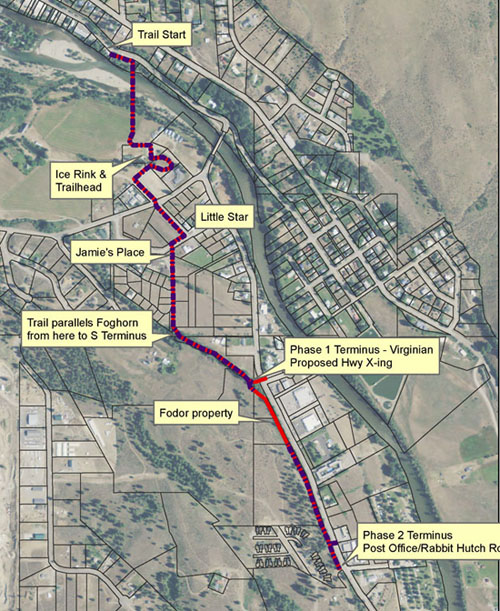|
Ditch vs. Trail
Susie Stephens funding at risk
by Solveig Torvik
The director of the state’s Recreation and Conservation Office, Kaleen Cottingham, met separately Oct. 31 in Winthrop with town officials and officers of the Fog Horn Ditch in an effort to solve an impasse over extension of the Susie Stephens Trail along the ditch.
The meetings came in the wake of an Oct. 17 meeting in Olympia of the Recreation and Conservation Office (RCO) funding board at which ditch acting president Dale Sekijima asked the board to remove the trail’s Phase II extension from the list of projects recommended to the governor and legislature for funding.
 Last July, workers with Mitchell Trucking and Paving of East Wenatchee put finishing touches on Phase I of the Susie Stephens Trail. This file image shows new asphalt where the first phase ends south of White Avenue across the street from Little Star Montessori School. Photo by Karen West
The board did not remove the trail from the list but gave the town until September 2013 to obtain legal “tenure and control” over the properties needed to complete the trail, according to town planner Rocklynn Culp.
Sekijima told the board that the town does not have legal tenure and control over the property needed for the trail and thus cannot legally complete it. He also said the ditch company has “no factual assurance” that the trail will not harm the ditch and its operations. “At a broad level, the town’s inability to provide timely, reasonable and substantive responses has evolved as an extreme concern for us,” Sekijima told the board.
Including costs of the Spring Creek Bridge over the Methow River, $3.3 million has been spent on Phase I to get the paved trail one-half mile from downtown near the Methow Conservancy to the Little Star Montessori School on Norfolk Road, according to Culp. Another three-fourths of a mile is to be added in Phase II to complete the trail, she said.
Among the ditch company’s concerns are liability for injuries to the public, possible damage to the ditch, maintenance and operation issues, added expenses to the company (a consortium of 55 irrigators) and right-of-way and ownership issues.
Ditch representatives also have the legal option of asking the legislature or the governor’s office to remove the trail from the list. Sen. Linda Evans Parlette, R-12th District and a member of the Senate Ways and Means Committee, told Grist she had been contacted by ditch officials by e-mail regarding trail funding. But Sekijima told Grist “We haven’t done anything” about requesting that Parlette strike the project from the list. “We were asking what the schedule was for legislation out of the RCO,” he said.
“I’m not taking sides,” said Parlette, who added “It’s way premature” to act on the issue at this point. But she warned that a necessary condition for any town seeking trail funding from the legislature is that its residents support the project. “It will hinder funding” if they don’t, she said, because there are too many other applicants whose citizens are in agreement about the projects for which their towns are requesting funds.
 The planned location of the Susie Stephens trail from its start near the Methow Conservancy office to its end across from the Post Office. The trail is built south to Little Star.
Cottingham told Grist that if the tenure and control conditions are met and the legislature approves the trail program funding at the RCO’s recommended levels, Winthrop’s request is likely to be granted since it ranks fourth on the list. The town has asked for $365,000 for the project and will provide a match of $365,000, which can be in-kind donations of labor, materials and land, according to Cottingham.
Asked if, after inspecting the proposed trail route and hearing the parties’ concerns, she sees a path forward for the town and ditch to reach a solution, Cottingham replied that “It would be premature” for her to comment. “I haven’t had enough time to digest what I’ve heard from everybody,” she said. But she added that she was made aware that lack of communication and mistrust were among issues contributing to the impasse.
If the rest of the trail is not completed within five years, said Culp, the town would become liable for repayment of some $50,000 to $60,000 to the state, probably in the form of conversion of other property to trail use, for a portion of the trail already completed.
Ditch officials have rejected a proposed memorandum of agreement in which the two parties would mutually indemnify one another, Culp said. The town offered to indemnify the ditch against legal claims arising from public use of the trail and asked the ditch company to indemnify the town against legal claims arising from ditch operations, according to Culp.
Sekijima told Grist he drafted the original memorandum of agreement. The town’s response “was essentially a complete rewrite, [a] … repositioning of the concept that I put down in the original memorandum,” he said. “They positioned the memorandum of agreement to basically say that we needed to have this agreement to be sure that the ditch could continue its operations,” he said. “Said another way, that is discounting our prescriptive easement and quit claim deed.”
The town’s version of the agreement is not as generous as it at first appears to be, he added. “I would characterize it as a subtle attempt to be able to say `We’re offering you indemnification but that really means we want the right to run all over your right of way and use your right of way without any restrictions.’ And furthermore, they actually limit the area where they are offering indemnification to where they cross the ditch” rather than along the entire ditch portion of the trail, he added. “Maybe if I had an IQ of 50 I’d think it was great,” he said of the town’s offer.
Sekijima also said he had asked for a six-foot high fence along a quarter mile where the trail adjoins the ditch but the town responded with a proposal of a four-foot open fence that someone “could crawl through” or vegetation.
Ditch officials also had asked that the town carry the ditch on its insurance policy but the insurer refused, said Culp.
“They sent a letter back saying that we had changed it too much and they no longer were interested in talking with us,” said Culp of the memorandum of agreement. “I’m frankly baffled by the whole thing,” she said, alluding to the impasse. “We feel really confident that we’re acting responsibly.”
 Asked what their next step is, Sekijima said ditch company officials are “hanging out to see what they (town officials) have to say for themselves.” Asked what their next step is, Sekijima said ditch company officials are “hanging out to see what they (town officials) have to say for themselves.”
Ditch officials have suggested that the trail run to the Winthrop post office on the east side of Highway 20 along the Methow River rather than along its present route west of Highway 20. But Culp, who was not town planner then, said that town documents from 1998 show that route was rejected as not being a viable option during a public trail scoping process. This was due to unwilling landowners as well as right-of-way and permitting issues along the shoreline and in the flood plain, she said.
“We operate based on the input we get from the public,” said Culp, and she said feedback to the town has been that the public supports the present trail route. “To change the route we’d have to go back to the public to get buy-in,” she said. That would mean starting at the beginning again. “It would take 10 years to get to where we are today,” she predicted. But, she added, “If the community opinion were to dramatically change, we would certainly step back and re-evaluate.”
The town also must acquire one other right-of-way or easement for the trail to cross property belonging to the Fodor family. It lies across Highway 20 from the Virginian motel. “They (RCO officials) let us know they were a little bit nervous that we don’t have that piece,” said Culp.
Negotiations for trail access through the Fodor property have proved fruitless, and the town has passed a resolution stating its intent to acquire access across the property by condemnation if negotiations fail. Culp said she expects the town to “reinstate communication with them (the Fodor family) in the next couple of weeks.”
Culp said that a 2009 title search by Baines Title and Escrow of Okanogan failed to disclose that the ditch company held a 1933 quit claim deed filed in 1940, not just a prescriptive easement based on historic use, to property along the ditch. So some portions of that property subsequently was “mistakenly acquired” by the town for the trail, she said. Ditch officials informed the town of the existence of the quit claim deed in a July 31, 2012, letter, Culp said, and the town has now asked the title company to verify that the quit claim document “is what is appears to be.”
The quit claim deed affects one of the two proposed bridge crossings over the ditch, according to Culp, at the southern end of the trail near the post office. The ditch company can legally prevent construction of a bridge across the ditch where the trail returns toward Highway 20 from the bottom of the hillside on the west side of the ditch, she said. However, added Culp, the final design for the trail’s southern terminus is still in flux. The other bridge over the ditch - south of the Friendship Church and across Highway 20 from the Virginian motel - could still be built as long as it does not interfere with ditch operations, said Culp, because that property is not covered by the quit claim deed.
Elsewhere "There is from one to five feet of overlap" of the trail with the ditch's quit claim deed along roughly 600 feet of the ditch, said Culp. But she added that even so, it's possible to build the trail because "we still own 15 feet and we're only proposing to build a trail that's 10 feet wide. In the worst case scenario we can narrow the trail but we can still build in that area," she said.
“Fog Horn can’t stop us from building the trail next to their ditch,” Culp said, since the town owns the land and has obtained most of the permits. “We can’t think of any reason they can prevent us from building it, aside from going the political route” to prevent the trail from being funded - “which is what they are working on.”
11/6/2012
|
